
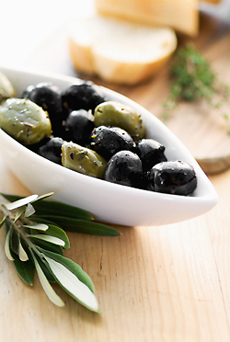 Terra Medi’s Mixed Olives with Fennel, Orange and Rosemary is one of the most delicious olive mixes we’ve ever had—perfect for entertaining or a gift. Photo by Ina Peters | IST. Terra Medi’s Mixed Olives with Fennel, Orange and Rosemary is one of the most delicious olive mixes we’ve ever had—perfect for entertaining or a gift. Photo by Ina Peters | IST.
|
ELIZABET TRAVIS is an Editorial Intern.
|
|
December 2007
|
 |
Terra Medi Bruschetta, Olives, Olive Oil, Tapenade& Vinegar
Greek Olives Make An Affordable “Find” For Olive Lovers
CAPSULE REPORT: Olive lovers have a friend in Terra Medi. The company imports top-quality olive oils, bruschettas, tapenades, olive mixes, vinegars and a sesame oil from Greece. The bruschettas and tapenades are versatile ingredients for entertaining or for sprucing up everyday meals. They have found permanent fans in us, and are well priced for gift giving.
It was the Greek goddess Athena who struck the earth with her spear and caused the olive tree to rise from the ground. It is considered by Greeks to be the most precious gift ever bestowed upon mortals, and beat out Poseidon’s contribution of the horse in a contest to see who would become protector of a newly-built city in the territory of Attica. Athena won with her olive tree and so the city was named Athens (just think—it could have been Poseidonos); olive trees have played a vital role in the Mediterranean ever since.
Production of olive oil is believed to have begun around 2000 B.C.E. It was immediately popular for its versatility in cooking, cosmetics, medicine, soap and lamp oil. Today, it is the basis for the widely-touted benefits of the Mediterranean diet.
Terra Medi, an American importer, strives to be as pure in the ingredients of its 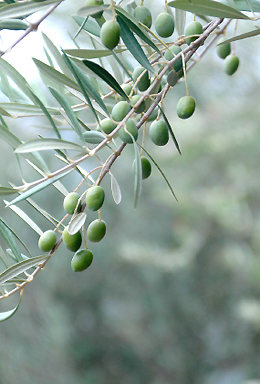 products as the birth of the olive tree itself. The product line is delicious and diverse, while sticking with what the founder, Apostolos Paralikas, knows: olives. Paralikas grew up working in his family’s olive groves on Peloponnesus, the large peninsula off the southeast coast of Greece, home to site of the cities of Argo, Corinth and Sparta. It has been a wonderful region for agriculture.* He brought the oils to America in 2000, set up shop with some friends. The name, Terra Medi, reflects the land of the Mediterranean. The sleek packaging has a design that represents three stacked olives. The bottles are lovely and graceful: We only wish that someone had taken out a tape measure. The oils and vinegars are 11¼ inches high, and our kitchen shelves (and we presume, those of others) are 11 inches apart, except for the tippy top shelf. (Alas, this is not an uncommon problem in the world of specialty oils and vinegars.) products as the birth of the olive tree itself. The product line is delicious and diverse, while sticking with what the founder, Apostolos Paralikas, knows: olives. Paralikas grew up working in his family’s olive groves on Peloponnesus, the large peninsula off the southeast coast of Greece, home to site of the cities of Argo, Corinth and Sparta. It has been a wonderful region for agriculture.* He brought the oils to America in 2000, set up shop with some friends. The name, Terra Medi, reflects the land of the Mediterranean. The sleek packaging has a design that represents three stacked olives. The bottles are lovely and graceful: We only wish that someone had taken out a tape measure. The oils and vinegars are 11¼ inches high, and our kitchen shelves (and we presume, those of others) are 11 inches apart, except for the tippy top shelf. (Alas, this is not an uncommon problem in the world of specialty oils and vinegars.)
Photo of olive branch by Hilary Brodey | IST.
*Unfortunately, in August 2007 large parts of Peloponnesus were devastated by wildfires that rank among the largest in the history of Europe. The impact of the fires on the economy of the region has not yet been tallied, but it is the largest environmental disaster in Greek history.
Terra Medi produces an all-natural (preservative-free) line of olive and sesame oils, olive bruschetta toppings, olive tapenade, jarred olive blends and balsamic, red and white vinegars. You could put together a light meal with just the addition of some bread and salad greens. Full of flavor, healthy and savvy, Terra Medi has something for anyone who loves Mediterranean food, and a lot for those of us who just can’t get enough olives.
Terra Medi Products
Sophocles called the olive tree, “the tree that feeds the children,” because of the its importance to Greece. Today, we think it is the tree that feeds the world. Almost everyone uses olive oil.
Terra Medi offers two extra virgin olive oils, along with a slew of products that would make wonderful gifts, or could work perfectly as appetizers, antipasto, snacks and tapas.
Extra-Virgin Oils
Extra virgin olive oils, made from the first pressing of the olives, have the lowest acidity and are therefore the best quality (not all first pressings achieve an acidity of 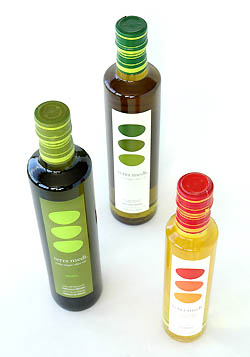 less than 1%; those that are 1% to 3.3% are virgin olive oil. The term “first cold pressed” or “cold pressed” is a term referring to the oils pressed by hydraulic presses, during the first press at room temperature (during subsequent pressings, heat was used to extract every iota of oil). Almost all olive oil sold to consumers is produced from a first pressing, with secondary pressings producing inferior, commercial-grade oils. Today, the centrifuge system is most commonly used, and hydraulic presses are hardly used. less than 1%; those that are 1% to 3.3% are virgin olive oil. The term “first cold pressed” or “cold pressed” is a term referring to the oils pressed by hydraulic presses, during the first press at room temperature (during subsequent pressings, heat was used to extract every iota of oil). Almost all olive oil sold to consumers is produced from a first pressing, with secondary pressings producing inferior, commercial-grade oils. Today, the centrifuge system is most commonly used, and hydraulic presses are hardly used.
Photo: From left, Organic Extra Virgin Olive Oil, Extra Virgin Olive Oil and Extra Virgin Sesame Oil.
The company uses 100% Greek Koroneiki olives in the oils (in fact, Greece is the third largest producer of olive oil in the world, and an estimated 60% of Greek olive oil production is Koroneiki). The Koroneiki is a small, oval, dark violet (when ripe) olive that is popular with olive oil producers because it is quick-growing, high yielding and has a high oil content (24%). It’s also naturally very resistant to insects and don't require spraying with insecticides, enabling Terra Medi to produce an organic oil as well. The olives ripen under the Mediterranean sun and are picked by hand and cold pressed (the common process for fine olive oil).
- Extra Virgin Olive Oil is buttery and smooth, with green apple and hay notes. With acidity levels less than 0.5%, this oil is supple and sweet—you could drink it from the cup.
- Organic Extra Virgin Olive Oil is less viscous than the regular Extra Virgin, but is very peppery. Whereas the Extra Virgin has no pepper whatsoever, the Extra Virgin invokes the classic back-of-the-throat, pepper cough—a night and day difference. Of course, most people don’t drink oil from tasting glasses, so you won’t be coughing when you use the oil for any normal purpose.Both oils can be used as bread dippers (snip in some fresh herbs), for grilling or marinating vegetables, and as a salad or a recipe ingredient.
- Extra Virgin Sesame Oil is made with cold-pressed sesame seeds, and produces a nice, light sesame oil—nothing like the dark-style Asian oils you may be familiar with. Tasting like liquid sesame seeds, this oil would be a perfect marinade for fish, or blended with rice.
Bruschettas
The word bruschetta comes from the verb in the Roman dialect, bruscare, meaning “to roast over coals.” Some food historians say it was developed in Tuscany to show off the new season’s olive oil, some say it dates back to Roman practices of using bread to 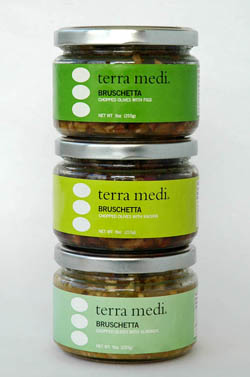 taste newly pressed olive oil, others say it was a way to use bread that was no longer fresh. Originally it was simply grilled bread, rubbed with a clove of garlic and topped with extra-virgin olive oil—the oil being the key ingredient. In recent times, a variety of toppings have been added to make it more of a snack: anchovies, beans, red peppers, tomatoes and other garden vegetables, cured meats, cheese—an open-faced sandwich of a sort. Americans typically use the word to refer to the topping itself, not the dish, and bottled “bruschetta” can be purchased of a classic restaurant mix of tomatoes, onion, garlic and herbs. taste newly pressed olive oil, others say it was a way to use bread that was no longer fresh. Originally it was simply grilled bread, rubbed with a clove of garlic and topped with extra-virgin olive oil—the oil being the key ingredient. In recent times, a variety of toppings have been added to make it more of a snack: anchovies, beans, red peppers, tomatoes and other garden vegetables, cured meats, cheese—an open-faced sandwich of a sort. Americans typically use the word to refer to the topping itself, not the dish, and bottled “bruschetta” can be purchased of a classic restaurant mix of tomatoes, onion, garlic and herbs.
Curiously, according to some food historians,† garlic bread was developed as a food for monied people, while bruschetta was a poor man’s oil-soaked bread, rubbed with garlic and charred over the fire. However, styles evolving as they do, garlic bread became the cheap way to deal with stale Italian bread (and a commodity available in any cheap Italian restaurant), while fancy-topped bruschetta is now served at the priciest restaurants.
†Wilson, Bee and Stonor Saunders, Frances, “Toast of the Tiber,” New Statesman, April 24, 2000 (p. 50).
Terra Medi has created three “bruschetta” toppings from olives, juxtaposing the natural saltiness of the olives with a sweet counterpoint. The olives are roughly chopped; each makes a good topping for bread (toasted or untoasted), pasta or pizza. You can also create unique version of “dirty rice” by mixing a bit of these into cooked rice; or serve them as a condiment with grilled chicken, lamb or pork. They make a terrific burger topping, too.
- Chopped Black Olives With Figs has a crunchy texture from chopped figs and a salty, earthy flavor from the olives that lingers on the tongue.
- Chopped Olives With Raisins is a mix of black and green olives, tomatoes, red bell peppers, capers and sea salt. The most complex of the three flavors.
- Green Olive With Almonds is the sweetest: The front label doesn’t indicate raisins, but they’re in there (and in the ingredients list). The texture is also the most charming, with small bits of crunchy almonds and whole plump golden raisins accompanying the olives; and there’s a lively piquancy from the vinegar, not found in the other two flavors.
Olivades (Tapenades)
While olive pastes have existed for as long as people have been eating olives, tapenade as we know it today was invented less than 100 years ago by the chef in the Maison 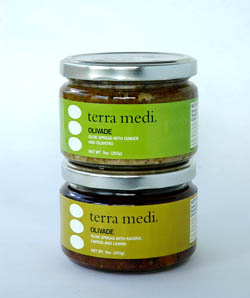 Dorée in Marseilles. He mixed finely chopped olives (many people purée them for a smooth paste), capers, olive oil and anchovies; the name of the dish is derived from the Provençal word for capers, tapéno. It is generally eaten as an hors d’œuvre, spread on bread or crackers or used as a dip for crudités; it also can be used to stuff fish fillets or as a topping for them under the broiler. Dorée in Marseilles. He mixed finely chopped olives (many people purée them for a smooth paste), capers, olive oil and anchovies; the name of the dish is derived from the Provençal word for capers, tapéno. It is generally eaten as an hors d’œuvre, spread on bread or crackers or used as a dip for crudités; it also can be used to stuff fish fillets or as a topping for them under the broiler.
Terra Medi has created two “olivades” that work as sandwich spreads as well (with cheese, chicken, meat and/or grilled vegetables). Also use the for hors d’oeuvres, topping with a bit of pimiento, a slice of hard-boiled egg, a bay scallop or anything else that strikes your fancy.
- Green Olives with Ginger and Cilantro has a strong lemon flavor and a mild zing. Though the cilantro and ginger aren’t forward flavors, this is a very tasty dip and spread.
- Kalamata Olives With Capers, Raisins And Lemon is a black olive spread. The whole raisins add nice texture and the capers give the tapenade a nice tartness. The lemon softens the saltiness—in fact, this is not a salty tapenade, but a nice blend of complex flavors. We recommend draining off the oil from the top of the jar; but put it to good use in a marinade or dressing.
Olive Mixes
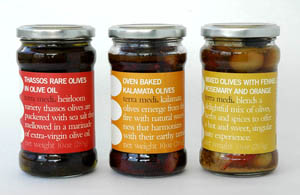 Tasting as fresh as from an open bin at your favorite gourmet store, these olive mixes are great to keep on hand for impromptu visits from hungry friends. The oils that each of them is packed in are very flavorful, and do double duty as bread dippers. Drain the olives into one dish and serve the oil in another, along with baguette slices. Tasting as fresh as from an open bin at your favorite gourmet store, these olive mixes are great to keep on hand for impromptu visits from hungry friends. The oils that each of them is packed in are very flavorful, and do double duty as bread dippers. Drain the olives into one dish and serve the oil in another, along with baguette slices.
- Baked Pitted Kalamatas have good, strong Kalamata olive flavor. They are baked to develop a sweetness that “harmonizes with their earthy tartness,” according to Terra Medi. Flavored with almonds, lemon and orange, red wine and grape must, roasted red pepper, herbs and spices, these Kalamatas deliver a more complex flavor than the plain-brined variety. Since they are already pitted, they can be tossed into salads or a Pasta Puttanesca.
- Mixed Olives with Fennel, Orange and Rosemary is our favorite of the olive mixes because of the tasty and fragrant fennel and rosemary, balanced by a light orange flavor, that imbue the green and black olive mix. The olive mix includes Amfissa, Halkidiki and Kalamata. It will satisfy the gourmand and the olive purist alike.
- Thassos Rare Olives are a black heirloom* olive with an earthy and salty flavor, having been cured in sea salt—but they are elegantly salty, and are potent with finesse. They rest in a marinade of extra virgin olive oil (with a bit of safflower oil), which is itself delicious.
*An heirloom vegetable or fruit cultivar or livestock breed is one that was commonly grown or raised in prior eras, but which is no longer part of modern large-scale agriculture. Before the industrialization of agriculture, a much wider variety of food was raised; but crops and animals are now raised to maximize consistency and profits. Varieties are generally selected for their productivity, ability to withstand mechanical picking and cross-country shipping, and their tolerance to drought, frost or pesticides. Nutrition, flavor and variety are not primary goals—which is why there is so little good-tasting fruit in America. While many of cultivars and breeds have become extinct as a result, small farmers have kept others alive.
Vinegars
A pleasant surprise was the high quality trio of vinegars produced by Terra Medi. Made with the flavorful Corinthian olive, the acidity of all three ranges from 6.5% to 7%. Whether for salads, recipes or a daily constitutional spoonful of vinegar, these vinegars are worth their modest investment.
- Balsamic Vinegar has a sweet quality with a thin pour. It isn’t a traditional balsamic, aged in a specific variety of woods; nor does it try to approximate it
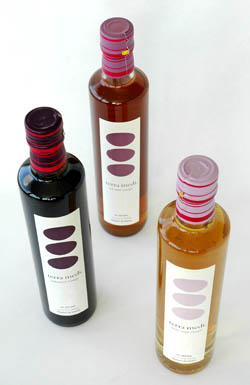 through artificial means. Instead, it has its own lovely, pruny flavor. This smooth yet robust vinegar would work well in salads, reductions, over fruit with cheese—it isn’t syrupy like an old tradizionale balsamic, but it is flavorful. through artificial means. Instead, it has its own lovely, pruny flavor. This smooth yet robust vinegar would work well in salads, reductions, over fruit with cheese—it isn’t syrupy like an old tradizionale balsamic, but it is flavorful.
- Red Wine Vinegar is perhaps the find of the collection. We have problems finding good red wine vinegar that delivers flavor without acid burn. The Corinthian grape used to make this vinegar produces a pure flavor with spice instead of burn (it’s the color of rosé). You can taste the wine it was made from: This is vinegar that avoids being too sour, tart or acrid.
- White Wine Vinegar has a nice white wine grape flavor, light and crisp. The beautiful golden color is derived from natural pigments in the grape skin. In a wine glass, without olfactory influence, you could mistake it for an aged white Burgundy.
With such a variety of riches from which to choose, where should one begin? We suggest a simple sampling of everything with sliced baguette—the perfect lunch or dinner.
Terra medi
Bruschetta, Extra Virgin Olive Oils, Olive Mixes, Sesame Oil, Tapenades, Vinegars
- Bruschetta
9-Ounce Jar
$6.99
- Olive Mixes
10-Ounce Jar
$6.99
- Extra Virgin Olive Oil
17-Ounce Bottle
$13.49
- Organic Extra Virgin Olive
Oil
17-Ounce Bottle
$16.99
- Olivade
9-Ounce Jar
$6.99
- Sesame Oil
8.5-Ounce Bottle
$7.99
- Vinegars
17-Ounce Bottle
Balsamic, $9.99
Red & White Wine, $6.99
|
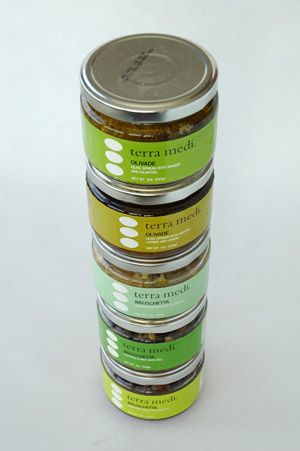
Stock up on a stack of Terra Medi spreads for hors d’oeuvres. Product shots by Dhanraj Emanuel. |
Purchase online at TerraMedi.com
Also available at select specialty food stores.
Price and product availability are verified at publication but are subject to change.

|





 products as the birth of the olive tree itself. The product line is delicious and diverse, while sticking with what the founder, Apostolos Paralikas, knows: olives. Paralikas grew up working in his family’s olive groves on Peloponnesus, the large peninsula off the southeast coast of Greece, home to site of the cities of Argo, Corinth and Sparta. It has been a wonderful region for agriculture.* He brought the oils to America in 2000, set up shop with some friends. The name, Terra Medi, reflects the land of the Mediterranean. The sleek packaging has a design that represents three stacked olives. The bottles are lovely and graceful: We only wish that someone had taken out a tape measure. The oils and vinegars are 11¼ inches high, and our kitchen shelves (and we presume, those of others) are 11 inches apart, except for the tippy top shelf. (Alas, this is not an uncommon problem in the world of specialty oils and vinegars.)
products as the birth of the olive tree itself. The product line is delicious and diverse, while sticking with what the founder, Apostolos Paralikas, knows: olives. Paralikas grew up working in his family’s olive groves on Peloponnesus, the large peninsula off the southeast coast of Greece, home to site of the cities of Argo, Corinth and Sparta. It has been a wonderful region for agriculture.* He brought the oils to America in 2000, set up shop with some friends. The name, Terra Medi, reflects the land of the Mediterranean. The sleek packaging has a design that represents three stacked olives. The bottles are lovely and graceful: We only wish that someone had taken out a tape measure. The oils and vinegars are 11¼ inches high, and our kitchen shelves (and we presume, those of others) are 11 inches apart, except for the tippy top shelf. (Alas, this is not an uncommon problem in the world of specialty oils and vinegars.) less than 1%; those that are 1% to 3.3% are virgin olive oil. The term “first cold pressed” or “cold pressed” is a term referring to the oils pressed by hydraulic presses, during the first press at room temperature (during subsequent pressings, heat was used to extract every iota of oil). Almost all olive oil sold to consumers is produced from a first pressing, with secondary pressings producing inferior, commercial-grade oils. Today, the centrifuge system is most commonly used, and hydraulic presses are hardly used.
less than 1%; those that are 1% to 3.3% are virgin olive oil. The term “first cold pressed” or “cold pressed” is a term referring to the oils pressed by hydraulic presses, during the first press at room temperature (during subsequent pressings, heat was used to extract every iota of oil). Almost all olive oil sold to consumers is produced from a first pressing, with secondary pressings producing inferior, commercial-grade oils. Today, the centrifuge system is most commonly used, and hydraulic presses are hardly used.  taste newly pressed olive oil, others say it was a way to use bread that was no longer fresh. Originally it was simply grilled bread, rubbed with a clove of garlic and topped with extra-virgin olive oil—the oil being the key ingredient. In recent times, a variety of toppings have been added to make it more of a snack: anchovies, beans, red peppers, tomatoes and other garden vegetables, cured meats, cheese—an open-faced sandwich of a sort. Americans typically use the word to refer to the topping itself, not the dish, and bottled “bruschetta” can be purchased of a classic restaurant mix of tomatoes, onion, garlic and herbs.
taste newly pressed olive oil, others say it was a way to use bread that was no longer fresh. Originally it was simply grilled bread, rubbed with a clove of garlic and topped with extra-virgin olive oil—the oil being the key ingredient. In recent times, a variety of toppings have been added to make it more of a snack: anchovies, beans, red peppers, tomatoes and other garden vegetables, cured meats, cheese—an open-faced sandwich of a sort. Americans typically use the word to refer to the topping itself, not the dish, and bottled “bruschetta” can be purchased of a classic restaurant mix of tomatoes, onion, garlic and herbs.  Dorée in Marseilles. He mixed finely chopped olives (many people purée them for a smooth paste), capers, olive oil and anchovies; the name of the dish is derived from the Provençal word for capers, tapéno. It is generally eaten as an hors d’œuvre, spread on bread or crackers or used as a dip for crudités; it also can be used to stuff fish fillets or as a topping for them under the broiler.
Dorée in Marseilles. He mixed finely chopped olives (many people purée them for a smooth paste), capers, olive oil and anchovies; the name of the dish is derived from the Provençal word for capers, tapéno. It is generally eaten as an hors d’œuvre, spread on bread or crackers or used as a dip for crudités; it also can be used to stuff fish fillets or as a topping for them under the broiler.  Tasting as fresh as from an open bin at your favorite gourmet store, these olive mixes are great to keep on hand for impromptu visits from hungry friends. The oils that each of them is packed in are very flavorful, and do double duty as bread dippers. Drain the olives into one dish and serve the oil in another, along with baguette slices.
Tasting as fresh as from an open bin at your favorite gourmet store, these olive mixes are great to keep on hand for impromptu visits from hungry friends. The oils that each of them is packed in are very flavorful, and do double duty as bread dippers. Drain the olives into one dish and serve the oil in another, along with baguette slices. through artificial means. Instead, it has its own lovely, pruny flavor. This smooth yet robust vinegar would work well in salads, reductions, over fruit with cheese—it isn’t syrupy like an old tradizionale balsamic, but it is flavorful.
through artificial means. Instead, it has its own lovely, pruny flavor. This smooth yet robust vinegar would work well in salads, reductions, over fruit with cheese—it isn’t syrupy like an old tradizionale balsamic, but it is flavorful. 